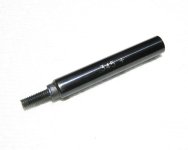I'd been looking at these for a couple years from Brownells for a couple years, but just never wanted to doll out for one. Finally decided I should have one for .38/.357, since I keep looking for more, and that is a pretty good check to do, so decided to get one.
When I tested it, it is a service grade, on my Model 10 - there was one cylinder that you can feel it sort of touch and then continue on when it goes into the cylinder. Is that something to be concerned about, or is that good enough.
If not good enough, is that something I could fix, or does that just get handed off to a pro gunsmith. Is there a common reason for just one to be off? When I visually looked at it, there were 2 that just by eye did not seem perfectly centered when locked up to me.
When I tested it, it is a service grade, on my Model 10 - there was one cylinder that you can feel it sort of touch and then continue on when it goes into the cylinder. Is that something to be concerned about, or is that good enough.
If not good enough, is that something I could fix, or does that just get handed off to a pro gunsmith. Is there a common reason for just one to be off? When I visually looked at it, there were 2 that just by eye did not seem perfectly centered when locked up to me.


